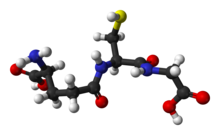Glutathione

| |

| |

| |
| Names | |
|---|---|
| IUPAC name
γ-Glutamylcysteinylglycine
| |
| Systematic IUPAC name
(2S)-2-Amino-5-({(2R)-1-[(carboxymethyl)amino]-1-oxo-3-sulfanylpropan-2-yl}amino)-5-oxopentanoic acid | |
| Other names
γ-L-Glutamyl-L-cysteinylglycine
(2S)-2-Amino-4-({(1R)-1-[(carboxymethyl)carbamoyl]-2-sulfanylethyl}carbamoyl)butanoic acid | |
| Identifiers | |
3D model (
JSmol ) |
|
| Abbreviations | GSH |
| ChEBI | |
| ChEMBL | |
| ChemSpider | |
| DrugBank | |
ECHA InfoCard
|
100.000.660 |
IUPHAR/BPS |
|
| KEGG | |
| MeSH | Glutathione |
PubChem CID
|
|
| UNII | |
CompTox Dashboard (EPA)
|
|
| |
| |
| Properties | |
| C10H17N3O6S | |
| Molar mass | 307.32 g·mol−1 |
| Melting point | 195 °C (383 °F; 468 K)[1] |
| Freely soluble[1] | |
| Solubility in methanol, diethyl ether | Insoluble[1] |
| Pharmacology | |
| V03AB32 (WHO) | |
Except where otherwise noted, data are given for materials in their standard state (at 25 °C [77 °F], 100 kPa).
| |
Glutathione (GSH,
Biosynthesis and occurrence
Glutathione biosynthesis involves two adenosine triphosphate-dependent steps:
- First, glutamate and L-cysteine. This conversion requires the enzyme glutamate–cysteine ligase (GCL, glutamate cysteine synthase). This reaction is the rate-limiting step in glutathione synthesis.[3]
- Second, glycine is added to the C-terminal of γ-glutamylcysteine. This condensation is catalyzed by glutathione synthetase.
While all animal cells are capable of synthesizing glutathione, glutathione synthesis in the liver has been shown to be essential. GCLC knockout mice die within a month of birth due to the absence of hepatic GSH synthesis.[4][5]
The unusual gamma amide linkage in glutathione protects it from hydrolysis by peptidases.[6]
Occurrence
Glutathione is the most abundant non-protein
Human beings synthesize glutathione, but a few eukaryotes do not, including some members of Fabaceae, Entamoeba, and Giardia. The only known archaea that make glutathione are halobacteria. Some bacteria, such as "Cyanobacteria" and Pseudomonadota, can biosynthesize glutathione.[9][10]
Systemic availability of orally consumed glutathione has poor bioavailability because the tripeptide is the substrate of
Biochemical function
Glutathione exists in reduced (GSH) and oxidized (GSSG) states.[16] The ratio of reduced glutathione to oxidized glutathione within cells is a measure of cellular oxidative stress[17][8] where increased GSSG-to-GSH ratio is indicative of greater oxidative stress.
In the reduced state, the thiol group of cysteinyl residue is a source of one
- NADPH + GSSG + H2O → 2 GSH + NADP+ + OH−
Roles
Antioxidant
GSH protects cells by neutralising (reducing) reactive oxygen species.[19][6] This conversion is illustrated by the reduction of peroxides:
- 2 GSH + R2O2 → GSSG + 2 ROH (R = H, alkyl)
and with free radicals:
- GSH + R• → 1/2 GSSG + RH
Regulation
Aside from deactivating radicals and reactive oxidants, glutathione participates in thiol protection and redox regulation of cellular thiol proteins under oxidative stress by protein S-glutathionylation, a redox-regulated post-translational thiol modification. The general reaction involves formation of an unsymmetrical disulfide from the protectable protein (RSH) and GSH:[20]
- RSH + GSH + [O] → GSSR + H2O
Glutathione is also employed for the detoxification of
It maintains exogenous antioxidants such as vitamins C and E in their reduced (active) states.[21][22][23]
Metabolism
Among the many metabolic processes in which it participates, glutathione is required for the biosynthesis of leukotrienes and prostaglandins. It plays a role in the storage of cysteine. Glutathione enhances the function of citrulline as part of the nitric oxide cycle.[24] It is a cofactor and acts on glutathione peroxidase.[25] Glutathione is used to produce S-sulfanylglutathione, which is part of hydrogen sulfide metabolism.[26]
Conjugation
Glutathione facilitates
In plants
In plants, glutathione is involved in stress management. It is a component of the
Uses
Winemaking
The content of glutathione in
See also
- Reductive stress
- Glutathione synthetase deficiency
- Ophthalmic acid
- roGFP, a tool to measure the cellular glutathione redox potential
- Glutathione-ascorbate cycle
- Bacterial glutathione transferase
- Thioredoxin, a cysteine-containing small proteins with very similar functions as reducing agents
- Glutaredoxin, an antioxidant protein that uses reduced glutathione as a cofactor and is reduced nonenzymatically by it
- Bacillithiol
- Mycothiol
- γ-L-Glutamyl-L-cysteine
References
- ^ ISBN 9781498754293.
- PMID 14555227.
- PMID 12814619.
- S2CID 25000753.
- PMID 10569624.
- ^ PMID 14988435.
- PMID 6020678.
- ^ PMID 22995213.
- PMID 12049666.
- ISBN 978-1-4020-0178-9– via Google Books.
- S2CID 27606314.
- ^ "Acetylcysteine Monograph for Professionals". Drugs.com.
- PMID 17602868.
- ^ Nagasawa, Herbert T. (27 November 2014). "COMPOSITIONS COMPRISING SUGAR-CYSTEINE PRODUCTS - US-20140348811-A1". ppubs.uspto.gov. United States Patent Office. p. 16. Retrieved 31 October 2023.
30. A method of increasing ATP and/or glutathione...
- PMID 37255827.
- PMID 35011559.
- PMID 11468240.
- PMID 23631642.
- PMID 15919781.
- PMID 19135374.
- S2CID 452394.
- S2CID 85414084.
- S2CID 4273230.
- PMID 10368185.
- S2CID 6467802.
- PMID 24981631.
- PMID 15822171.
- PMID 15012235.
- PMID 10368185.
- PMID 17144898.
- PMID 18444899.
- .
- PMID 25457918.
